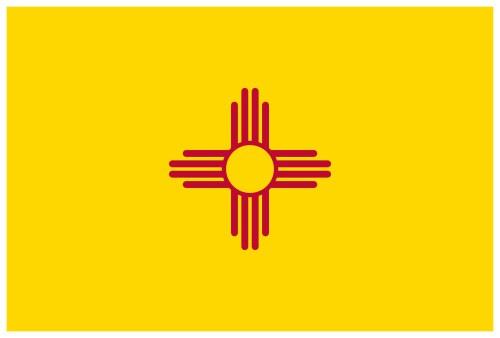
Flag of New Mexico, USA
February
Weather in February
February in New Mexico is characterized by a continuation of the winter season, with temperatures somewhat resembling those of January. However, as the month progresses, there's a gradual transition as temperatures inch upwards, signifying the slow approach of spring.
The diversity in New Mexico's terrain yields varied weather experiences across the state during February. Higher-altitude cities and regions, especially those located in Northern and Central New Mexico, often still witness snowfall in February, accumulating between 20" (508mm) to 30" (762mm). Yet, as one travels southward, the climate becomes milder, and snowfall decreases. Southern parts of New Mexico, for instance, usually experience minimal snow, typically below 5" (127mm).
Temperature-wise, February sees daytime highs averaging 55°F (12.8°C) and nighttime lows near 25°F (-3.9°C). This month does not hold any extreme values, yet it serves as a transitional period from the cold winter to the milder temperatures of March. Compared to January, February offers slightly warmer days, but cold nights persist, especially in the mountainous regions.
The diversity in New Mexico's terrain yields varied weather experiences across the state during February. Higher-altitude cities and regions, especially those located in Northern and Central New Mexico, often still witness snowfall in February, accumulating between 20" (508mm) to 30" (762mm). Yet, as one travels southward, the climate becomes milder, and snowfall decreases. Southern parts of New Mexico, for instance, usually experience minimal snow, typically below 5" (127mm).
Temperature-wise, February sees daytime highs averaging 55°F (12.8°C) and nighttime lows near 25°F (-3.9°C). This month does not hold any extreme values, yet it serves as a transitional period from the cold winter to the milder temperatures of March. Compared to January, February offers slightly warmer days, but cold nights persist, especially in the mountainous regions.
- Albuquerque - February »
In Albuquerque in February, snow falls for 3.8 days, with typically accumulated 1.46" (37mm) of snow. In Albuquerque, during February, the rain falls for 3.9 days and regularly aggregates up to 0.39" (10mm) of precipitation. - Las Cruces - February »
In Las Cruces during February, the rain falls for 3.4 days and regularly aggregates up to 0.35" (9mm) of precipitation. In Las Cruces, during February, the rain falls for 3.4 days and regularly aggregates up to 0.35" (9mm) of precipitation. - Rio Rancho - February »
In Rio Rancho, during February, snow falls for 3.3 days and regularly aggregates up to 2.01" (51mm) of snow. In Rio Rancho, during February, snow falls for 3.3 days and regularly aggregates up to 2.01" (51mm) of snow. - Santa Fe - February »
January, February, November and December, with an average maximum UV index of 2, are months with the lowest UV index in Santa Fe, New Mexico. The months with the least sunshine in Santa Fe are January, February and December, with an average of 7.1h of sunshine. - Farmington - February »
In Farmington during February, the rain falls for 5.8 days and regularly aggregates up to 0.91" (23mm) of precipitation. In Farmington, during February, snow falls for 6.8 days and regularly aggregates up to 3.9" (99mm) of snow. - Clovis - February »
The months with the most snowfall in Clovis are January and February, with an average 1.34" (34mm) of accumulated snow. In Clovis during February, the rain falls for 2.8 days and regularly aggregates up to 0.39" (10mm) of precipitation. - Hobbs - February »
In Hobbs, in February, snow falls for 1.8 days, with typically accumulated 0.83" (21mm) of snow. In Hobbs in February, it is raining for 2.7 days, with typically 0.24" (6mm) of accumulated precipitation. - Alamogordo - February »
During 0.9 snowfall days, in February, Alamogordo aggregates 0.79" (20mm) of snow. In Alamogordo during February, the rain falls for 3.2 days and regularly aggregates up to 0.35" (9mm) of precipitation. - Carlsbad - February »
The month with the least rainfall in Carlsbad is February, when the rain falls for 2.4 days and typically collects 0.16" (4mm) of precipitation. In Carlsbad, in February, snow falls for 0.9 days, with typically accumulated 0.59" (15mm) of snow. - Gallup - February »
In Gallup, in February, during 5.5 snowfall days, 2.56" (65mm) of snow is typically accumulated. In Gallup, during February, snow falls for 5.5 days and regularly aggregates up to 2.56" (65mm) of snow. - Deming - February »
In Deming in February, snow falls for 0.5 days, with typically accumulated 0.16" (4mm) of snow. On the first day of February in Deming sunrise is at 7:04 am and sunset at 5:44 pm. - Los Lunas - February »
In Los Lunas during February, snow falls for 3.5 days and regularly aggregates up to 1.38" (35mm) of snow. In Los Lunas, New Mexico, during February, the rain falls for 5.6 days and regularly aggregates up to 0.43" (11mm) of precipitation.
Updated: May 24, 2024
Published by: Weather U.S. | About Us
Data Sources | Weather Forecasting & Climate
Published by: Weather U.S. | About Us
Data Sources | Weather Forecasting & Climate